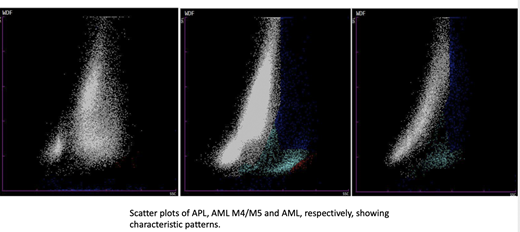Introduction:
Acute promyelocytic leukemia (APL) is one of the hematological emergencies requiring early detection and treatment. The hematology laboratory plays a pivotal role in management. The correct morphological identification of APL is made even before the confirmation by the cytogenetic or molecular analysis. Automated hematology analyzers are the backbone of the hematology laboratories. Other than providing routine counts and differentials, they are also capable of producing sufficient information in the form of leucocyte cell population data (CPD) scatter plots depicting the leucocyte subpopulation. These data are primarily underutilized, particularly in assessing the lineage of various hematopoietic neoplasm. Here we analyzed the utility of leucocyte CPD and the pattern of scatter plot in Sysmex XN 1000 analyzer for the detection of acute promyelocytic leukemia.
Materials and Results:
We included 100 controls and 100 AML cases. Leucocyte CPD parameters were compared along with scatter plots from the WDF channel from Sysmex XN1000 analyzer were recorded and analyzed. Immunophenotyping and molecular analysis confirmed the diagnosis in all but two cases, where the patients expired within a few hours of admission in the emergency.
Out of a total of 100 cases, 22 were labeled as APL, 63 as AML, and 15 as AML M4/M5. Among the APL cases, in 19 cases, immune-phenotyping was done on peripheral blood, and the remaining three bone marrow aspirate samples were used.
The scatter-plot analysis of APL cases showed a characteristic pattern which differentiated this entity from other acute myeloid leukemias. In the case of APL, on Side Fluorescence Light Scatter (SFL) Vs. Side scatter (SSC), the abnormal promyelocytes occupy the space above neutrophils and to monocytes' right, where the immature precursors of myeloid are usually found. In cases where the total leukocyte count was within the normal range, a hiatus between these abnormal promyelocytes and neutrophils are seen. This finding was consistent in all cases irrespective of the morphological variation. On the other hand, other variants of acute myeloid leukemias along with monoblastic leukemias, the scatter plots show the blasts in the monocytic region with extension to the ceiling. On comparison, the myeloblast and monoblasts lie more towards the y-axis than abnormal promyelocytes.
All the CPD parameters were compared against the control group and the AML group. The cell population data showed a significant difference in all the parameters representing the side fluorescence, size and granulations except LY-WX (width of dispersion of side scatter) when compared to normal healthy controls. Amidst all the AML cases, APL significantly differed from other cases in NE-SFL, LY-WY, and MO-WZ. AML M4/M5 and APL also varied in LY-Y, NE-WY, NE-WZ, and MO-WY. AMLs excluding AML M4/M5 showed additional variation in MO-Y and MO-Z.
Discussion:
APL cases have a characteristic scatter plot patter on SFL Vs. SSC. The scatter-plot shows a tear-drop like a collection of cells. These cells have high side scatter and high lateral fluorescence owing to the large size of the cells, apple-core like the nucleus, and dense granulations. The differences in the CPD parameters among APL cases and controls and other acute myeloid leukemia can be attributed to these morphological features of the abnormal promyelocytes.
Haider et al. found a significant difference between NE-SFL and other myeloid leukemia. [1] This was in corroboration with our findings. Another research done by Park et al. showed that NE-SFL and MO-WX had the highest sensitivity and specificity in differentiating APL from other AML. [2]
Conclusion:
We conclude that the new age automated cell counters provide numerous data that remains unexplored and can be utilized further along with the information from the scatter plots to make a rapid diagnosis of Acute Promyelocytic Leukemias.
References:
Haider R.Z., Ujjan I.U., Shamsi T.S. Cell Population Data - Driven Acute Promyelocytic Leukemia Flagging Through Artificial Neural Network Predictive Modeling. Translational Oncology, 2020;13(1):11-16.
Park SH, et al. Cell population data NE-SFL and MO-WX from Sysmex XN-3000 can provide additional information for exclusion of Acute Promyelocytic Leukemia from other Acute Myeloid Leukemias: A Preliminary Study. Ann Lab Med 2016;36:607-610.
No relevant conflicts of interest to declare.
Author notes
Asterisk with author names denotes non-ASH members.


This feature is available to Subscribers Only
Sign In or Create an Account Close Modal